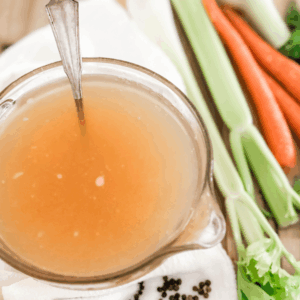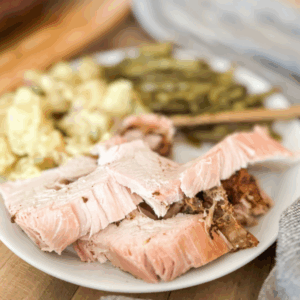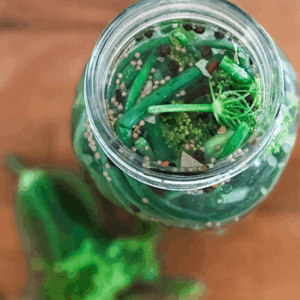How to Freeze Swiss Chard and Other Leafy Greens

This post may contain affiliate links, which means I make a small commission at no extra cost to you.
See my full disclosure here.
Learn how to freeze Swiss Chard and other leafy greens so you can preserve your spinach, chard, kale and other garden greens for the winter.
The process is simple, and frozen greens take up very little freezer space. You will love the convenience of pulling out a frozen puck of greens and plunking it into your simmering soup over the winter months.

One of my favorite soups to add fresh or frozen greens to is this Sausage & Sweet Potato Soup with Spinach. Even though the recipe calls for spinach, any leafy greens can be used.
Personally, I love knowing that the leafy greens growing in my garden can be stretched to last my family all year long. I also love cooking with as many homegrown veggies as possible, but of course this same method can be applied to greens from the farmer’s market or even from the grocery store.
By the way, you might like these 11 Ways to Use Swiss Chard and other leafy greens.
Additionally, these blanched and frozen leafy greens are perfect for adding to smoothies. Since too many raw leafy greens can be problematic for hypothyrodism, I like to use cooked greens whenever I can.
Ready for the simple method?
How to Freeze Swiss Chard & Other Leafy Greens
First, I’ll share the steps in a quick overview. Then I’ll provide more specifics for each step.
And if you’re a visual learner, or if you want to see my nifty steamer basket, you’ll want to check out this video I made to show you the entire process.
Basic steps:
- Strip leaves from stalks.
- Blanch leaves for a few minutes in boiling water.
- Immediately plunge leaves into an ice bath.
- Drain wet leaves.
- Squeeze as much water as possible from the leaves.
- Chop leaves.
- Fill silicone muffin cups with chopped leaves.
- Freeze.
- Remove from muffin cups and store in a freezer safe container.

More details…
1. Strip leaves from stalks.
For kale, chard, or greens with thick or tough stalks. Skip this step for spinach or baby greens.
2. Blanch leaves for a few minutes in boiling water.
Fill a large cooking pot with water and bring to a boil. Use a steamer basket to submerge leaves in boiling water for about 3 minutes.
You may also want to have a wooden spoon handy for pushing the leaves below the boiling water, as they have a tendency to float to the surface.

3. Immediately plunge leaves into an ice bath.
In the meantime, prepare an ice bath. Use a bowl or pot large enough to contain your steamer basket.
After the greens have boiled for about three minutes, transfer the steamer basket from the cooking pot to the ice bath. Keep the greens in the ice water for the same amount of time they spent in the boiling water.
4. Drain wet leaves.
Lift the basket above the water and give it about 30 seconds to drain excess water into the ice bath. Transfer the basket to an old or dark dish towel. Allow it to drain there for at least a few minutes or even longer.
5. Squeeze as much water as possible from the leaves.
When the leaves are finished dripping, tumble them out onto the towel. Use the towel to squeeze the remaining water from the greens.
6. Chop leaves.
When you’re satisfied that the leaves are reasonably dry-ish, transfer them to a cutting board and chop into bits.

7. Fill silicone muffin cups with chopped leaves.
Squeeze the chopped greens into a muffin tin. I’ve found that silicone baking cups work best because later, you can pop the frozen pucks right out.
8. Freeze.
Place the greens-filled baking cups in the freezer and freeze overnight or until frozen solid.
9. Remove from muffin cups and store in a freezer safe container.
When the pucks are frozen solid, pop them out and store them in a freezer bag or container. Don’t forget to lable the bag with the date and contents!

10. Enjoy until next year.
Now for the rest of the year, you can enjoy the convenience of pulling out a puck or two and adding them to soups and other dishes. You get to stretch out your greens harvest to last all year long, until fresh greens are once again growing in your garden.
What’s your favorite way to preserve leafy greens?
More veggies you can freeze:
22 NOURISHING GLUTEN-FREE SOUP RECIPES
Simplify your dinner prep with these tasty, nourishing soups!

Sign up NOW for my best tips delivered weekly to your inbox!
You’ll also get instant access to my library of free ebooks and resources.
You might also like...
6 responses to “How to Freeze Swiss Chard and Other Leafy Greens”
-
This process for preserving swiss chard and other leafy greens has been so helpful this year! My swiss chard has been plentiful, and I don’t want to see any of this powerhouse go to waste. I’ve been using this method to preserve beet greens and kale, too! I can’t wait to cook a nice hearty soup this fall and winter and be able to pull out some frozen greens from the freezer that we grew! Thanks for sharing this method!
-
Yes, Stevie, you’ll LOVE tossing homegrown frozen greens into soups and other dishes. 🙂
-
-
Hello, useful information, but you do need to replace the baking sheet! It affects the credibility of your blog.
-
I’m glad you found these instructions useful, Jean. About the baking sheet–I don’t actually use it for baking! It has such a wonderful patina that I often use it for food photography. And the rimmed edges make it handy for flash freezing produce, but don’t worry: I always line it with parchment paper first. 🙂
-
-
Do you have ideas on how to use or freeze the stems?
-
Sometimes I chop and dehydrate the stems, and add them to soups/stews/chili.
-








Leave a Comment